International Traveller – Singapore
- December 30th, 2011
- Posted in Lifestyle
- Write comment

Panoramic view, overlooking downtown Singapore at night, from atop the tallest building.
What an eye opening experience, 10.5 hour flight to Japan, stopover for 3 hours, 7.5 hour flight to Singapore. Vice-versa on the way back. Got an opportunity to fly Singapore Airlines, and can’t say enough good things about them.
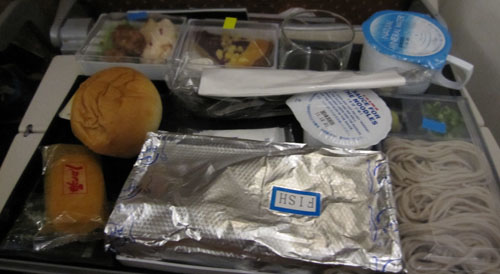
Singapore Airlines food tray... with steel cutlery, awesome.
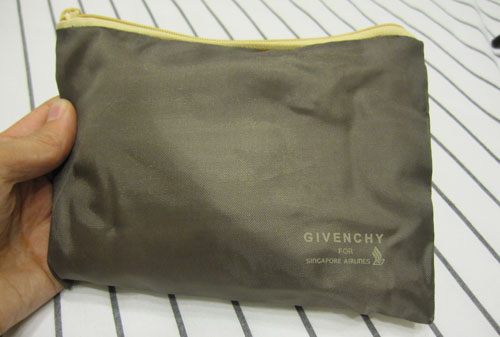
Singapore Airlines complimentary gift bag with toothbrush, toothpaste, and socks... Givenchy? Awesome.
The previous ideas of Singapore that I held were very stereotypical: no gum, no spitting, clean streets, safe to walk at night alone, big brother government, canings. Looks like there are some merit to those claims, however, it’s easy to get crazy ideas about them. It’s not all black and white; some clarification is needed, and there are even more interesting tidbits about Singapore to be aware of.
Here, I will attempt to interpret my experience there.
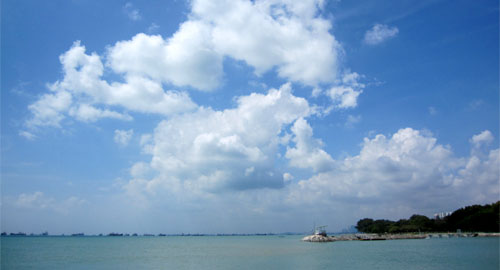
Looking down the southern shoreline towards downtown Singapore from East Coast Park.
Singapore sits just north along the Earths’ equator, there are no changing seasons aside from whether it’s raining or not, lots of daylight, the sun rises and sets at pretty much the same time everyday. It’s always tropical warm (at least 30 degrees celsius), and extremely humid. Step out into the jungle-fresh climate, out of the near-freezing air conditioned malls and you just feel the moisture attach itself to your skin like dripping sweat after a hard workout.
An international hub, and a central location smack in the middle of various cultures and countries, Singapore has 5 million inhabitants, roughly 60% are native Singaporeans, while the rest are ex-pats (foreigners), or service workers (labour force from Phillipines/Bangladesh etc). English is an official language +1.
The currency exchange worked out in my favour, $0.77 CAD to their $1 SGD.
Commonly differentiated terms, and good to know tidbits:
When speaking to men and women older than yourself, they are referred to with the honourific title of “Uncle” and “Auntie” respectively
Tipping is not customary, neither is customer service
When eating out, and obviously a foreigner/tourist, be sure to ask about and be aware of the price of food items beforehand… see here for more details
“2 for 1” is referred to as “1 for 1”
“Open Bar” is referred to as “Freeflow”
“Per person” is referred to as “PER PAX” or “PAX” in a plural setting (bus, group etc)
“Take out” is referred to as “Take away” in a food ordering setting
Don’t expect refunds or exchanges at most small outfitters, or even the chance to try them on before purchase
Public display of the middle finger is considered an offence, and is punishable
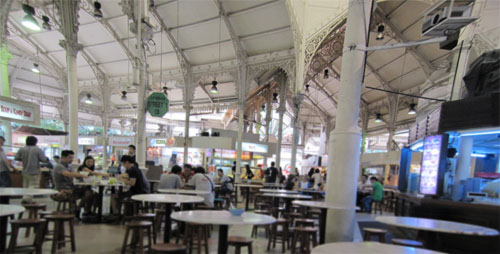
A sheltered hawker center in the business district of Raffles, on a Saturday.
Food is generally abundant, with the majority of Singaporeans and ex-pats eating out at hawker food stalls. Take note that local dishes are far cheaper than western branded dishes and restaurants. Also, tipping is not customary, and customer service is rare, it’s all business here.
Hawker food stalls are a must, usually in a sheltered outdoor area with no A/C. Eat in and the food comes in non-disposable eating ware/cutlery etc, order for “take-away” (take out) and you may be charged extra. As for drinks don’t be surprised to get the delicious liquid in a stringed plastic sandwich bag… at least you get a straw. Another surprise for me… no complimentary napkins! Unless you’re near a Starbucks, buy some, you will need them, good thing there are plenty of old men and ladies selling packs of 3-5 for $1 at the hawker food courts… and they like to target foreigners.
Must-try local favorites, with the best description I can give for western newbies:
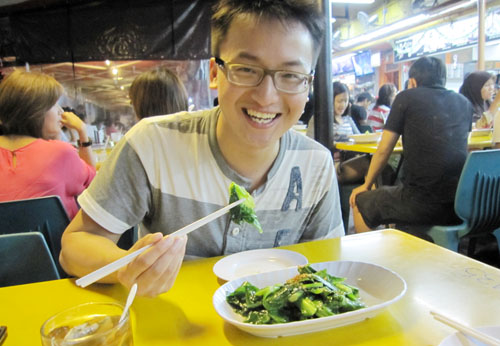
I'm loving the baby Kai-Lan in oyster sauce, with fried shallots.
Baby Kai-lan in Oyster Sauce – topped with fried shallots ($, just as it sounds, a simple vegetable dish that turned out to be my favorite dish while being there, very common)
Prata – Indian style crepe, ($, I like the Cheese, Mushroom, or the filling Chicken Murtabak, common)
Chili/Black Pepper Crab – a Singapore original, Chinese Mud Crab that comes in other various sauce bases like butter ($$$$+, varying in size, even the small crabs have much bigger claws and leg thickness than a large Western Dungeness crab, so good, common)
Nasi-Lemak – Malaysian platter of rice, egg, split anchovies, cucumber, and chili sauce as its’ base ($, nice breakfast, very common)
Fish Noodle Soup – Noodles with assorted toppings like fish balls in a chicken/fish broth ($, cheap and hearty, very common)
Milo – Similar to Ovaltine, a chocolate-y type beverage ($, I recommend a Milo Dinosaur, very common)
Bandung – A beverage made from rose water, mixed with milk, sugar, and pink food colouring ($, personally not my cup of tea, still worth a try, very common)
Fresh Young Coconut Water and Pressed Sugarcane Juice ($, my personal favorites, try to find places that use fresh sugar cane stalks at order rather than the stalls reusing old pressed ones, you’ll notice the difference, +1 if you get it in a bag :D, very common)
There is also a place called Tom’s Palette that serves homemade ice cream. They have a lot of flavours, and are located inside the SB Shaw Tower building at the three way intersection of Middle Rd and Beach Rd. I attended an ice cream making workshop they had (expensive, $60 SGD per pax), and was greatly pleased (all you can eat ice cream too). I also had a lot of fun with the dry ice they gave me when taking my completed ice cream home.

EZ Link transit fare cards.
The public transit system (MRT, SMRT, TransitLink) is a vast network of rail trains (above and underground) and road buses that are responsible for the everyday commutes for the majority of Singaporean inhabitants. They use a “pay as you go” fare system, with the most popular being an “EZ Link” fare card which looks and acts like a debit card that you can top up. You scan the card when entering or leaving MRT stations and buses, getting a discount over the standard single trip fares.
One thing I’d love to see improved… notification of coming stops while on the bus. If you don’t know where your stop is, your almost screwed, since the bus stop sign is 99% almost always on the opposite, far end side of a bus stop when being approached, and blocked by the bus stop shelter, meaning that you can only read it when you leave the bus stop, looking behind you as the bus drives past it.
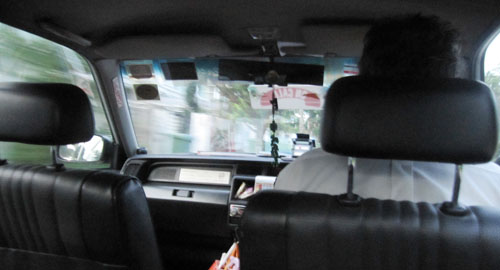
Riding in the back of a taxi.
Taxis are very affordable for the middle income individual, and plentiful. If you feel like you’re overcharged, ask for a receipt and call the cab company to state your claim. Although expect a higher costing trip to and from the airport, no matter how close your destination/location.
Since I’m on the subject of transit, let’s discuss the road and driving conditions. Singapore has by far, in my opinion, some of the cleanest, well paved, and well structured road systems I can imagine. There are many, intelligently placed, yellow no stopping zones to distinguish parking lot and bus exiting lanes/areas, many cement dividers between opposite traffic, and highly visible signs and lanes. I must admit, the Singapore government did a fantastic job on them.
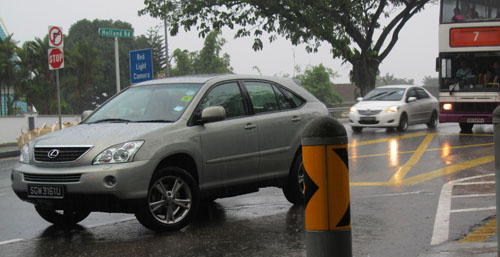
A driver stops their vehicle across 2 lanes, preventing a bus from entering the bus stop to unload and pickup passengers.
It is unfortunate though, that the vast majority of car drivers in Singapore are not able to fully utilize the road systems in a considerate manner. For a country about 45 years old, it has some obvious growing room.
There is very little in the way of road courtesy. It is very common to see cars not signal when performing a lane change, or cut people off (at least by my definition), and take up 2 lanes while driving on the lane divider. It also appears that traffic laws are not strictly enforced. I’ve seen more than my share of car accidents in my time in Singapore than I would want, and was almost involved in one early in my trip.
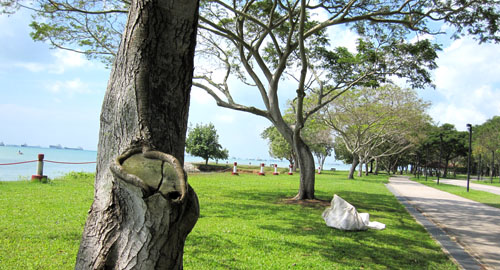
A walkway along East Coast Park.
I was walking along the sidewalk of a narrow and winding residential road, when a speeding driver off a curve approached the stop sign at the intersection I was in the middle of crossing… without any intention to stop. Luckily for both of us, he did come to a screeching stop (infuriated I might add). Also, it’s not just the wealthy asian drivers (I was in an upscale houses only area), I’ve seen ex-pats block buses from leaving the bus stop, and apparently they don’t have the right of way either, maybe that’s the norm? Seems odd to me.
Owning a vehicle is grossly expensive, with good cause. To limit vehicles on the road, a restricted number of COE’s (Certificate of Entitlement) are issued and required for vehicle ownership, which costs a ridiculous amount of money (it can vary daily), on top of the cost, insurance, and 95 octane-level-only fuel costs. Also, it only lasts 10 years at max, which then requires the Singapore resident to scrap or export the vehicle. Aside from being a show of wealth (status), this probably is one of the factors that fuels a sense of entitlement for those wealthy enough to afford vehicles, and possibly, their poor driving conduct.
Regardless, lesson learned, don’t drive in Singapore, and don’t take chances with crazy self-righteous drivers.
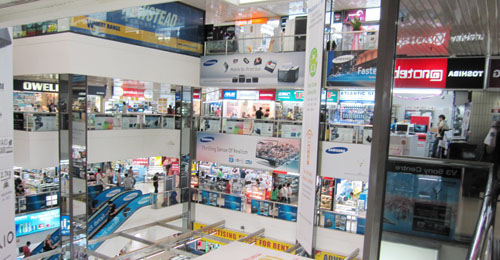
The infamous technology-gadget mall, Sim Lim Square.
Shopping is apparently one of the major past-times for Singaporeans. However, in my outings, I rarely ever saw something that I could not get for far cheaper here in Canada. Anything North American branded is expensive, so best save your cash on more worthwhile ventures, like food, and maybe some foot reflexology.
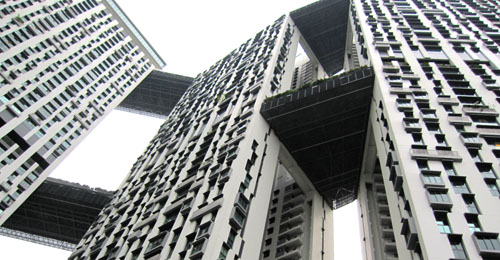
A Singapore HDB building (Housing Development Board).
If you plan on staying awhile, one very important subject to consider is the living costs. Vancouver is one of the most livable cities in the world, and is very costly due to being so, however, Singapore dwarfs Vancouver in that regard. The cost of renting/owning property is much more expensive, probably due to the fact that Singapore is an island with limited land mass, its’ length at its’ longest is roughly 30 km, and it’s width at its’ widest is about 8km.
Luckily for me, I had the good fortune of staying my entire time in Singapore with a colleague and friend of mine – free of charge – whom with his 2 other house-mates, rent out a fully furnished mansion sized duplex-half (3 floors all above ground level, 2 kitchens, maids’ quarters, 4 master-size, 1 medium-size bedrooms with complete attached closet and bathroom, 20 feet(?) ground level ceilings, dining room, living room) for $6000/month plus utilities (5000 sqft on their side). Utilities are around $1000/month, and that’s mostly spent on air conditioning and electricity.
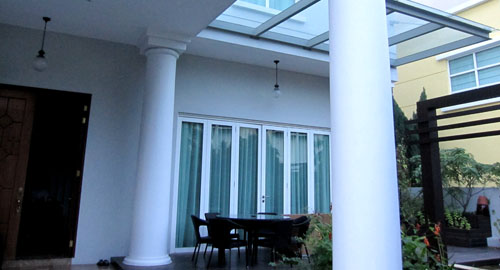
The house.
Now if that sounds like a pretty decent deal, that is because it is. It’s a steal of a deal from their perspective. I was told by a local recruiter that an average 3 room HDB flat (Housing Development Board aka government subsidized housing condo/apartment) in the downtown area starts at roughly $3000/month rent (1 bedroom, 1 dining room, and 1 living room all count as rooms… beware), whereas an upscale 2 bedroom condo in the Coal Harbour area of downtown Vancouver cost me $1800/month rent; and that was already too expensive for my taste.
Throughout Asia, it is common to not have hot water tanks on all the time, Singapore is no exception, and there is little use of hot water, except for say cleaning dishes. It’s so warm and humid, cold showers are a god-send, even though the water running out of the faucet is only lukewarm at its’ coldest.
Gotta love Singaporean marketing. Where else will you find an anti-mosquito poster that shows a cute little girl playing with her doll, and a giant Photoshopped mosquito hovering above her with the phrase, “Your precious child, her nightmare is about to begin,” or the label on packaged spinach, “Vitamin secured”? On multiple occasions, I saw actors/athletes on billboard advertisements, and they would have the title, “International Artist/Athlete” followed by their name, hence the inspiration for the title. I’m not letting go of that one, too good. I even saw a purchase-adspace advertisement on a trash can that read a quote from somebody I forgot, “Creativity without strategy is art. Creativity with strategy is advertising.” If that’s the case, Singapore could use some new tacticians, maybe I should be a consultant?
Back to the beginning, yes, you cannot buy chewing gum, and if you get caught bringing gum in, it gets thrown out, although I’ve heard that anti-smoking gum may be purchasable with prescription, and possibly some forms of dental hygiene supportive gum. It is, however, to the best of my knowledge, not illegal to own it.
Not selling chewing gum stems from the discouragement of spitting in public places, since the easiest way of getting rid of it is to spit it out, might as well make spitting illegal – to a degree. I’ve seen just one person spit, and it was into the grated drain sewers, never on any place where there was solid, paved ground.
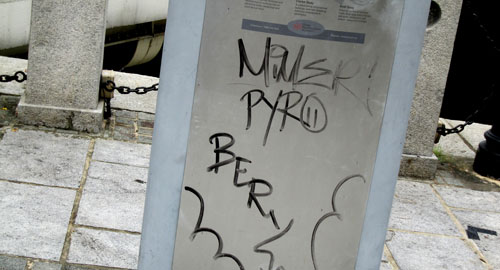
The only piece of vandalism seen on the trip, along Clarke Quay, it was removed a few days later.
The streets are very clean, and no graffiti. The “graffiti” I managed to see being paid works of art in the Clarke Quay district, and on Arab street. However, it is not to say that all is well, I did manage to spot one piece of vandalism, a graffiti tag on a public sign in Clarke Quay, and intentionally littered garbage, probably from cars driving along Upper East Coast Road in Bedok where there is shrubbery between the road and the sidewalk. Needless to say, both were promptly removed/cleaned up a few days later when I had returned to the areas, talk about acting fast.
Relatively safe to walk around at any time, day or night, this is probably due to several factors like enforcing a strict code for misconduct, harsh punishments, and lots of cameras to enforce them. Also Singapore is mostly an evening/night city, and it comes alive after dark. Surprisingly, I rarely ever saw a police officer in uniform or a vehicle for that matter.
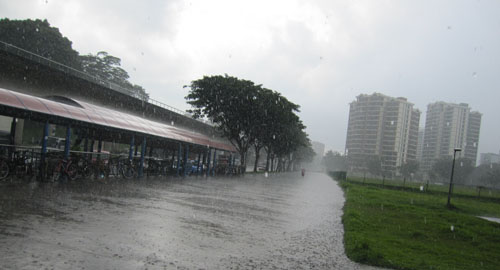
Monsoon downpour out of nowhere.
There are no cold nights, and when it rains, it rains hard (especially during monsoon season), in fact, the heat and humidity is easier to deal with at night, and so encourages people to step out more. Hardly any eatery or establishment is open at 9:30am, let alone 7am. Hawker stations can be open from 10am, to 6am the next morning.
No secret about it, there are cameras almost everywhere, on the bus, in the malls, in the taxis, at the stations, and on the street. Although it doesn’t eliminate crime completely, it’s amazing how different we act as a society when we know we are being observed.
Canings are a form of punishment to discourage criminal/inappropriate behaviour. Apparently, the system works itself out pretty well, although public canings have ceased (from my knowledge), while private canings are still held.
That pretty much wraps up Singapore in a nutshell (long nutshell). In the end, I had a wonderful time, largely due to my local friends in the area and the great company they provided, so, if you’re into Yoga, and happen to be in Singapore, go to Republic of Yoga, you can check out their new website here.
Cheers.
All the images in this article were taken on the trip.
Great write up! I want to see pics!!!!
Love it bro, sounds like you having a blast!
Thanks man, it definitely was!